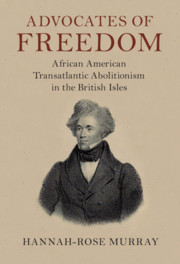Book contents
- Advocates of Freedom
- Slaveries since Emancipation
- Advocates of Freedom
- Copyright page
- Contents
- Figures
- Acknowledgments
- Dedication
- Introduction
- 1 “It Is Time for the Slaves to Speak”
- 2 “All the Bloody Paraphernalia of Slavery”
- 3 “[They Have] Not Ceased to Hold My Hand Since”
- 4 To “Frighten the Hyena Out of His Ferocity”
- 5 “I Would Much Rather Starve in England, a Free Woman, Than Be a Slave”
- 6 “Have No Fellowship I Pray You, with These Merciless Menstealers”
- 7 “My Name Is Not Tom”
- 8 “The Black People’s Side of the Story”
- Conclusion
- Bibliography
- Index
7 - “My Name Is Not Tom”
Josiah Henson, Uncle Tom’s Cabin, and Adaptive Resistance after the Civil War 1876–1877
Published online by Cambridge University Press: 07 September 2020
- Advocates of Freedom
- Slaveries since Emancipation
- Advocates of Freedom
- Copyright page
- Contents
- Figures
- Acknowledgments
- Dedication
- Introduction
- 1 “It Is Time for the Slaves to Speak”
- 2 “All the Bloody Paraphernalia of Slavery”
- 3 “[They Have] Not Ceased to Hold My Hand Since”
- 4 To “Frighten the Hyena Out of His Ferocity”
- 5 “I Would Much Rather Starve in England, a Free Woman, Than Be a Slave”
- 6 “Have No Fellowship I Pray You, with These Merciless Menstealers”
- 7 “My Name Is Not Tom”
- 8 “The Black People’s Side of the Story”
- Conclusion
- Bibliography
- Index
Summary
Chapter 7 moves beyond most scholarly accounts of Black abolitionist transatlantic visits to the British Isles and focuses on Josiah Henson in the time period 1876–1877. I analyze his lecturing tour, his visit to Windsor Palace to meet Queen Victoria, and the numerous artistic responses to him, which included a revised performance of Uncle Tom’s Cabin on the stage, a bust in the Royal Academy, and a wax model in Madame Tussaud's. I argue that Henson exploited adaptive resistance in an entirely new age and to do this, he needed to reawaken British interest and lecture about the memory of slavery. He used assimilationist language to capitalize on his association with the character of Uncle Tom from Harriet Beecher Stowe’s Uncle Tom’s Cabin to win fame (and fortune) on the British stage. However, Henson had to negotiate racial stereotypes and work in a climate that whitewashed the nation’s own bloody history of slavery in favor of a romanticized plantation ideal in America. Henson fought against this at every turn and contributed to the Black American protest tradition in Britain a decade after the end of the Civil War.
Keywords
- Type
- Chapter
- Information
- Advocates of FreedomAfrican American Transatlantic Abolitionism in the British Isles, pp. 255 - 291Publisher: Cambridge University PressPrint publication year: 2020

